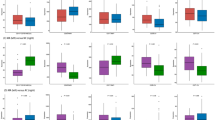Abstract
The percentage manifesting dysplasia in bone marrow needed to qualify as significant is ≥10 % in each lineage. However, detailed analyses of this threshold have not been reported. Here, we analyzed dyserythropoiesis (dysE) in 109 myelodysplastic syndromes (MDS) patients with 21 immune thrombocytopenia (ITP)/12 hemolytic anemia (HA) patients as a control. In present study, mild megaloblastic erythroblasts were specifically named ‘red cell with abnormal chromatin clumping (RCACC)’. RCACC ≥10 % in erythroblasts was observed in 29 % of ITP patients and 58 % of HA patients. The numbers of MDS patients with RCACC in erythroblasts <10, 10–19 and ≥20 % were 1, 3, and 105, respectively. We analyzed dysE criteria according to the WHO classification (original WHO dysE). Most of our MDS patients (98 %) had original WHO dysE ≥20 %. The ITP patients with original WHO dysE ≥10 % was 48 %, and there were no ITP patients had original WHO dysE ≥20 %. Sixty-seven percent of HA patients had original WHO dysE ≥10 %, and three patients (25 %) had original WHO dysE ≥20 %. Raising the threshold of the original WHO dysE from 10 to 20 or 30 % may provide more suitable criteria. If RCACC is not included in dysE criteria, we think that ‘10 %’ is a suitable threshold for the determination of dyserythropoiesis.





Similar content being viewed by others
References
Malcovati L, Porta MG, Pascutto C, Invernizzi R, Boni M, Travaglino E, et al. Prognostic factors and life expectancy in myelodysplastic syndromes classified according to WHO criteria: a basis for clinical decision-making. J Clin Oncol. 2005;23(30):7594–603.
Bennett JM, Catovsky D, Daniel MT, Flandrin G, Galton DA, Gralnick HR, et al. Proposals for the classification of the myelodysplastic syndromes. Br J Haematol. 1982;51(2):189–99.
Jaffe ES, Harris NL, Stein H, Vardiman JW, editors. World Health Organization classification of tumours. Pathology and genetics. Tumours of haematopoietic and lymphoid tissues. Lyon: IARC Press; 2001.
Swerdlow SH, Campo E, Harris NL, editors. WHO classification of tumours of haematopoietic and lymphoid tissues. 4th ed. Lyon: IARC Press; 2008.
Wickramasinghe SN. Diagnosis of megaloblastic anaemias. Blood Rev. 2006;20(6):299–318.
Kaushansky K, Lichtman M, Beutler E, Kipps K, Prchal J, Seligsohn U, editors. Williams hematology. 8th ed. New York: McGraw-Hill Professional; 2010.
Jimenez-Balderas FJ, Morales-Polanco MR, Gutierrez L. Acute sideroblastic anemia in active systemic lupus erythematosus. Lupus. 1994;3(3):157–9.
Carpenter SL, Zimmerman SA, Ware RE. Acute parvovirus B19 infection mimicking congenital dyserythropoietic anemia. J Pediatr Hematol Oncol. 2004;26(2):133–5.
Marsh JC, Ball SE, Cavenagh J, Darbyshire P, Dokal I, British Committee for Standards in Haematology, et al. Guidelines for the diagnosis and management of acquired aplastic anaemia. Br J Haematol. 2009;147(1):43–70.
Vardiman JW. Hematopathological concepts and controversies in the diagnosis and classification of myelodysplastic syndromes. Hematol Am Soc Hematol Educ Program. 2006;2006:199–204.
Bain BJ. The bone marrow aspirate of healthy subjects. Br J Haematol. 1996;94(1):206–9.
Parmentier S, Schetelig J, Lorenz K, Kramer M, Ireland R, Schuler U, et al. Assessment of dysplastic hematopoiesis: lessons from healthy bone marrow donors. Haematologica. 2012;97(5):723–30.
Ramos F, Fernandez-Ferrero S, Suarez D, Barbon M, Rodriguez JA, Gil S, et al. Myelodysplastic syndrome: a search for minimal diagnostic criteria. Leuk Res. 1999;23(3):283–90.
Matsuda A, Germing U, Jinnai I, Iwanaga M, Misumi M, Kuendgen A, et al. Improvement of criteria for refractory cytopenia with multilineage dysplasia according to the WHO classification based on prognostic significance of morphological features in patients with refractory anemia according to the FAB classification. Leukemia. 2007;21(4):678–86.
Maslak P. Refractory Anemia with excess Blasts-2. ASH Image Bank. http://imagebank.hematology.org/Default.aspx. Accessed 15 Aug 2015.
Vardiman JW. Myelodysplastic Syndrome: Refractory Anemia with Ringed Sideroblasts (RARS)-5. http://imagebank.hematology.org/Default.aspx. Accessed 15 Aug 2015.
Della Porta MG, Travaglino E, Boveri E, Ponzoni M, Malcovati L, et al. Minimal morphological criteria for defining bone marrow dysplasia: a basis for clinical implementation of WHO classification of myelodysplastic syndromes. Leukemia. 2015;29(1):66–75.
Bennett JM. Morphological classification of the myelodysplastic syndromes: how much more education of diagnosticians is necessary? Haematologica. 2013;98(4):490–1.
Kerr E, Kiyuna T, Boyle S, Saito A, Thomas JS, Bickmore WA. Changes in chromatin structure during processing of wax-embedded tissue sections. Chromosome Res. 2010;18(6):677–88.
Acknowledgments
This work was supported in part by Grants-in Aid for Scientific Research from the Japanese Ministry of Education, Culture, Sport, Science, and Technology (26461431), by the National Cancer Center Research and Development Fund (26-A-24), and by Grants-in-Aid from the Project for the Development of Innovative Research on Cancer Therapeutics (P-direct).
Author information
Authors and Affiliations
Corresponding author
Ethics declarations
Conflict of interest
The authors have no potential conflict of interest to report.
About this article
Cite this article
Kawai, N., Matsuda, A., Jinnai, I. et al. Proposal of criteria for dyserythropoiesis in the diagnosis of myelodysplastic syndromes. Int J Hematol 103, 227–233 (2016). https://doi.org/10.1007/s12185-015-1916-8
Received:
Revised:
Accepted:
Published:
Issue Date:
DOI: https://doi.org/10.1007/s12185-015-1916-8




